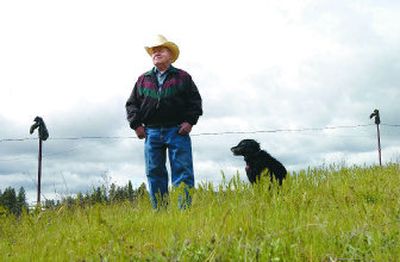Boots on a fence summon a fleeting era

Consider the cowboy boots hanging from a tired, barbed wire fence as your car shoots the ever-closing gap between top-dollar subdivisions described as “highly desirable” and “nicely landscaped.”
As you pull onto the chewed gravel shoulder of this narrow rural road to accommodate a truck delivering custom cabinets and another churning concrete, consider those worn-out Tony Lamas stained dark red by the spring rain and dripping. There’s a hole in the sole of one boot where the ball of a man’s left foot broke through years ago and kissed the pebbly Saltese soil. Stories are worn into the soles of these boots, stories of colts broken and calves raised and slaughtered at this crossroad of East 32nd Avenue and Linke Road.
Consider what it all means and how these shriveled leather shapes fit into the ever-changing puzzle that is the West, a puzzle without edges. Like so much of what’s been done out here the fence is what it is, according to Bob Storm, just because.
“I just put them out there,” said Storm, a 70-something cowboy, who in the tradition of cowboys keeps his small talk short and simple. His dog Sam, a “pure-blooded black dog,” seems to sense all that needs to be said had been said and turns his attention to the ground.
“I do some leather work, and I’d keep my old boots so I could make a pair of kid’s holsters for cap pistols,” Storm said. “They were all worn out when I put them out there.”
There’s a Blucher boot handmade in Storm’s home state of Oklahoma. The brand was once worn by President Reagan. Beside it are the boots of Storm’s grandson and great-grandson. His own scuffed size 71/2 soles cap the rest of the line.
Rust, the hoarfrost of yesteryear, gnaws at the 14-stake, two-strand barbed wire fence. Consider there was a time when every field in these parts sported an iron crown of thorns. This type of barbed wire, patented by Illinois farmer Joseph Glidden, was most common. It sports two jagged little stingers every six inches that are held in a defensive stance by a simple twist. The barbless twists between the points are called lays.
Glidden’s Type A barbed wire features five lays between the barbs. He made the wire in the 1870s to keep his cows out of his wife’s garden, but ranchers from Texas to Washington had bigger plans. They could partition tree-barren land from Ritzville, Wash., to Pasco and never worry about running out of lumber.
It didn’t rot. The wind didn’t blow it down, and anyone who didn’t respect it soon bore the barb’s telltale tear on the back of his shirt. Cows generally respected barbed wire, and by putting an end to herds’ commingling, ranchers were able to establish bloodlines. Consider how barbed wire dominated the West for more than a century only to be replaced by the white vinyl privacy fences of gated neighborhoods.
For all the construction going on around him, Storm’s corner west of Saltese Flats is in repose. The west end of his fence is anchored by the Greenacres Grange Hall. It is a white chapelesque building registered for its historic significance but also boarded up for lack of use. Grange is an organization devoted to protecting the farm way of life. Houses are the bumper crop in the surrounding pastures now.
The pasture land on the fence’s north side belongs to the Grangers who years ago appointed Storm the pasture’s caretaker, allowing his cows to feed on its grass in return. The cows are gone, and the grass reaches closer to the fence’s bottom barbed wire strand with every rain.
Storm’s fence has evoked strange responses from neighbors who weren’t here when he moved to the area 30 years ago.
A couple of years ago someone (Storm suspects a female) stopped by in the middle of the night, unseated all Storm’s boots and replaced them with high heels. The old cowboy laughed, and then he nailed the woman’s shoes to a board and posted them beneath his mailbox. He never did meet the foot that graced the 14 heels.
Not long after that incident, someone left him a new pair of boots beneath the woman’s shoes. The boots were too big for Storm, but they fit his grandson, who put them to use.
Think about the landscape those boots now walk across. Think about where they might hang when they’re worn through.
Even Storm has grown accustomed to the comfort of tennis shoes. No one hangs tennis shoes from a vinyl fence.